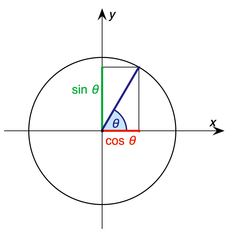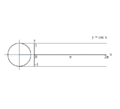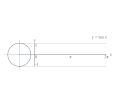History
Sumerian astronomers studied angle measure, using a division of circles into 360 degrees.[4] They, and later the Babylonians, studied the ratios of the sides of similar triangles and discovered some properties of these ratios but did not turn that into a systematic method for finding sides and angles of triangles. The ancient Nubians used a similar method.[5]
In the 3rd century BC, Hellenistic mathematicians such as Euclid and Archimedes studied the properties of chords and inscribed angles in circles, and they proved theorems that are equivalent to modern trigonometric formulae, although they presented them geometrically rather than algebraically. In 140 BC, Hipparchus (from Nicaea, Asia Minor) gave the first tables of chords, analogous to modern tables of sine values, and used them to solve problems in trigonometry and spherical trigonometry.[6] In the 2nd century AD, the Greco-Egyptian astronomer Ptolemy (from Alexandria, Egypt) printed detailed trigonometric tables (Ptolemy's table of chords) in Book 1, chapter 11 of his Almagest.[7] Ptolemy used chord length to define his trigonometric functions, a minor difference from the sine convention we use today.[8] (The value we call sin(θ) can be found by looking up the chord length for twice the angle of interest (2θ) in Ptolemy's table, and then dividing that value by two.) Centuries passed before more detailed tables were produced, and Ptolemy's treatise remained in use for performing trigonometric calculations in astronomy throughout the next 1200 years in the medieval Byzantine, Islamic, and, later, Western European worlds.
The modern sine convention is first attested in the Surya Siddhanta, and its properties were further documented by the 5th century (AD) Indian mathematician and astronomer Aryabhata.[9] These Greek and Indian works were translated and expanded by medieval Islamic mathematicians. By the 10th century, Islamic mathematicians were using all six trigonometric functions, had tabulated their values, and were applying them to problems in spherical geometry.[citation needed] At about the same time, Chinese mathematicians developed trigonometry independently, although it was not a major field of study for them. Knowledge of trigonometric functions and methods reached Western Europe via Latin translations of Ptolemy's Greek Almagest as well as the works of Persian and Arabic astronomers such as Al Battani and Nasir al-Din al-Tusi.[10] One of the earliest works on trigonometry by a northern European mathematician is De Triangulis by the 15th century German mathematician Regiomontanus, who was encouraged to write, and provided with a copy of the Almagest, by the Byzantine Greek scholar cardinal Basilios Bessarion with whom he lived for several years.[11] At the same time, another translation of the Almagest from Greek into Latin was completed by the Cretan George of Trebizond.[12] Trigonometry was still so little known in 16th-century northern Europe that Nicolaus Copernicus devoted two chapters of De revolutionibus orbium coelestium to explain its basic concepts.
Driven by the demands of navigation and the growing need for accurate maps of large geographic areas, trigonometry grew into a major branch of mathematics.[13] Bartholomaeus Pitiscus was the first to use the word, publishing his Trigonometria in 1595.[14] Gemma Frisius described for the first time the method of triangulation still used today in surveying. It was Leonhard Euler who fully incorporated complex numbers into trigonometry. The works of the Scottish mathematicians James Gregory in the 17th century and Colin Maclaurin in the 18th century were influential in the development of trigonometric series.[15] Also in the 18th century, Brook Taylor defined the general Taylor series.[16]
Overview
Main article: Trigonometric function
If one angle of a triangle is 90 degrees and one of the other angles is known, the third is thereby fixed, because the three angles of any triangle add up to 180 degrees. The two acute angles therefore add up to 90 degrees: they are complementary angles. The shape of a triangle is completely determined, except for similarity, by the angles. Once the angles are known, the ratios of the sides are determined, regardless of the overall size of the triangle. If the length of one of the sides is known, the other two are determined. These ratios are given by the following trigonometric functions of the known angle A, where a, b and c refer to the lengths of the sides in the accompanying figure:
- Sine function (sin), defined as the ratio of the side opposite the angle to the hypotenuse.
- Tangent function (tan), defined as the ratio of the opposite leg to the adjacent leg.
The hypotenuse is the side opposite to the 90 degree angle in a right triangle; it is the longest side of the triangle and one of the two sides adjacent to angle A. The adjacent leg is the other side that is adjacent to angle A. The opposite side is the side that is opposite to angle A. The terms perpendicular and base are sometimes used for the opposite and adjacent sides respectively. Many people find it easy to remember what sides of the right triangle are equal to sine, cosine, or tangent, by memorizing the word SOH-CAH-TOA (see below under Mnemonics).
The reciprocals of these functions are named the cosecant (csc or cosec), secant (sec), and cotangent (cot), respectively:
The inverse functions are called the arcsine, arccosine, and arctangent, respectively. There are arithmetic relations between these functions, which are known as trigonometric identities. The cosine, cotangent, and cosecant are so named because they are respectively the sine, tangent, and secant of the complementary angle abbreviated to "co-".
With these functions, one can answer virtually all questions about arbitrary triangles by using the law of sines and the law of cosines. These laws can be used to compute the remaining angles and sides of any triangle as soon as two sides and their included angle or two angles and a side or three sides are known. These laws are useful in all branches of geometry, since every polygon may be described as a finite combination of triangles.
Extending the definitions
The above definitions only apply to angles between 0 and 90 degrees (0 and π/2 radians). Using the unit circle, one can extend them to all positive and negative arguments (see trigonometric function). The trigonometric functions are periodic, with a period of 360 degrees or 2π radians. That means their values repeat at those intervals. The tangent and cotangent functions also have a shorter period, of 180 degrees or π radians.
The trigonometric functions can be defined in other ways besides the geometrical definitions above, using tools from calculus and infinite series. With these definitions the trigonometric functions can be defined for complex numbers. The complex exponential function is particularly useful.
See Euler's and De Moivre's formulas.
Mnemonics
Main article: Mnemonics in trigonometry
A common use of mnemonics is to remember facts and relationships in trigonometry. For example, the sine, cosine, and tangent ratios in a right triangle can be remembered by representing them and their corresponding sides as strings of letters. For instance, a mnemonic is SOH-CAH-TOA:[17]
- Sine = Opposite ÷ Hypotenuse
- Cosine = Adjacent ÷ Hypotenuse
- Tangent = Opposite ÷ Adjacent
One way to remember the letters is to sound them out phonetically (i.e., SOH-CAH-TOA, which is pronounced 'so-kə-toe-uh' /soʊkəˈtoʊə/). Another method is to expand the letters into a sentence, such as "Some Old Hippie Caught Another Hippie Trippin' On Acid"












No comments:
Post a Comment